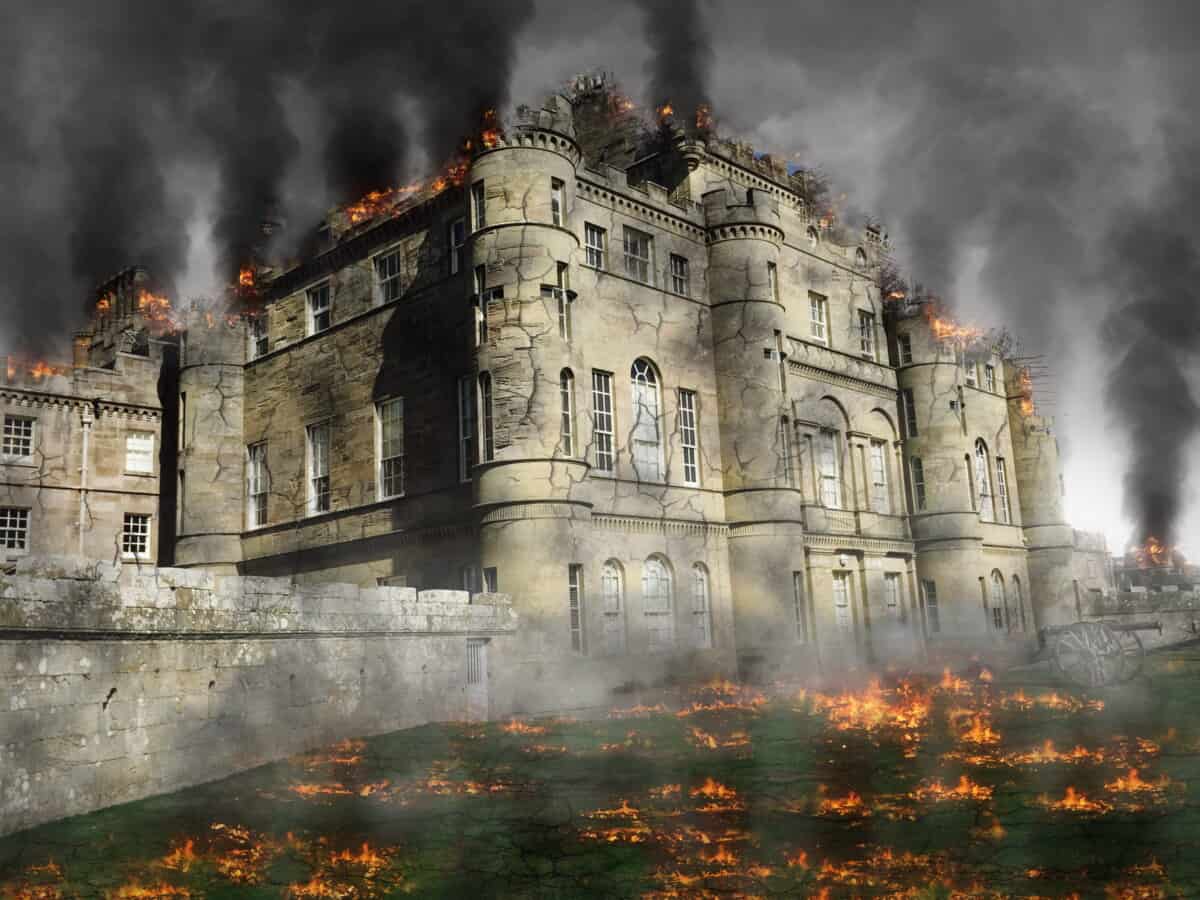Despite their mighty and impregnable look, you might ask yourself, could fire wreck a castle back then?
Yes, in the castles where builders involved supporting elements like wood or other flammable materials, fire will most likely collapse the whole stronghold to the ground. However, a few castles mainly made of stone could resist severe burning, yet leaving a portion of cracking in the stone and mortar.

Was there any fire precaution measure in the Middle Ages that could prevent the loss of the most expensive buildings back then?
How were castles protected against fire in the Middle Ages?
Unlike today back in Medieval times, there was no such thing as fire safety or risk assessments; many masonries made castles without much thinking involved.
Castles and medieval homes were made of highly flammable materials like straw, wood and daub.
But, given these flammable materials, master-masons built parts of a castle unintentionally to resist fire.
Such examples consist of slated tile roofs and stone walls. Castles also had gates and large towers to prevent attackers from destroying a castle and triggering more fires.
How were fortification doors protected against fire?
Back in the days of castle building, people built medieval and ancient fortifications with thick wooden doors to serve as gates. These wooden gates would be in the middle of stone walls.
However, these wooden doors were often questionable compared to the stone structures; these could be easy to penetrate. All it would take would be a splash of oil and an arrow set on fire to make a large hole in the wall in only a matter of hours.
But surprisingly, these wooden doors were quite thick, iron-studded wooden door, that was hard to breakthrough.
Towards the 12th and 13th centuries, castle gates were protected by a metal barrier called portcullis. Gate guards lowered it from a chamber above the gateway.
To penetrate such gates, armies attacking would have to bash the doors down or scale them to attack the occupants.
The fire used in the sieges of the castle
If a stone castle was well built and had a fair amount of resolute men, it could prevent a siege from happening.
However, sieges did occur, which set fire to the castle, but it was done using mechanical siege machines and miners’ help.
In a siege, miners would dig under a wall and fill a tunnel with combustibles.
Such a tactic King John successfully used at the siege of Rochester Castle in 1215.
They tumbled Rochester’s tower with the help of mine and 40 pigs fat which they set on fire.
Once a castle tunnel was filled, they were set alight to make sure the masonry and essential areas of the castle, like the tunnel wall, was burnt away.
Mongols, for example, were incredibly tactical during sieges by burning tar, setting flaming catapults and trebuchets.
They would also set fire to wheels and roll along to burn the castle. If the flaming sieges worked well, the tunnel would collapse alongside the wall.
Inhabitants of a castle would also pour hot sand, boiling water or quicklime to stop attackers from climbing ladders and walls.
Most of the time, defenders of a castle would commonly use water to put out fires during sieges.
What is the Slighting of a Castle
Slighting the castle is a process of intentionally damaging a medieval fortress or other high-status building to reduce its military, social, or administrative value.
It would not be uncommon for an owner to lose the whole castle in an attack or certain parts of the court, so it would not fit others to live.
Sometimes a king or queen would command someone to come and dismantle a castle if the builder did not ask for their permission to construct it.
Back then, many landlords often repaired their castles once slighted, and the others were left abandoned.
The ruins at Kenilworth and Corfe are a preserved reminder of such cruel procedure applied to many strongholds in the English Civil War.
Famous Castles that went through a fire
Throughout history, many famous castles caught fire; a few popular ones were:
Windsor Castle 1992
On the 20th of November in 1992, the largest inhabited castle in the world caught fire. The fire spread to the whole of the court and caused a lot of damage, some of which was irreversible.
The damage cost around £36.5 million to repair, and there were over a few hundred firemen to tackle the blaze. However, in terms of restoration to the castle, over £60 million was raised to reestablish it to its original form.
Shuri Castle 2019
Shuri Castle is a 500-year-old Unesco World heritage site situated in Okinawa, Japan. It took over 10 hours for around 100 firefighters to put out the flames and preserve the magnificent Japanese castle.
Shuri castle was also nearly burnt to the ground in World War II. Formerly Shuri Castle housed the Ryuku dynasty and was built between 1429-1879.
Conclusion
If you’re wondering whether castles can burn down, that’s a yes, but not all of them. Most of the time, when a fort burns down, it’s usually its flammable parts like the wood and the stone left to remain.
Generally, a fire would cause the brick and mortar of the castle to expand and then create cracks in the stone, causing it to fall into rubble.
The flammable parts of a castle-like castle gate would often have iron bars behind them covered with leather or animal skins to stop it from setting on fire.
Most of the time, these doors weren’t set on fire and more likely to be penetrated by attackers.


